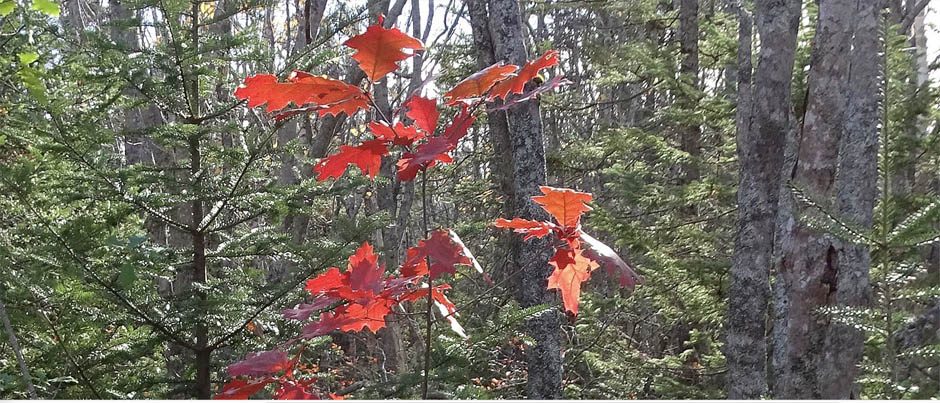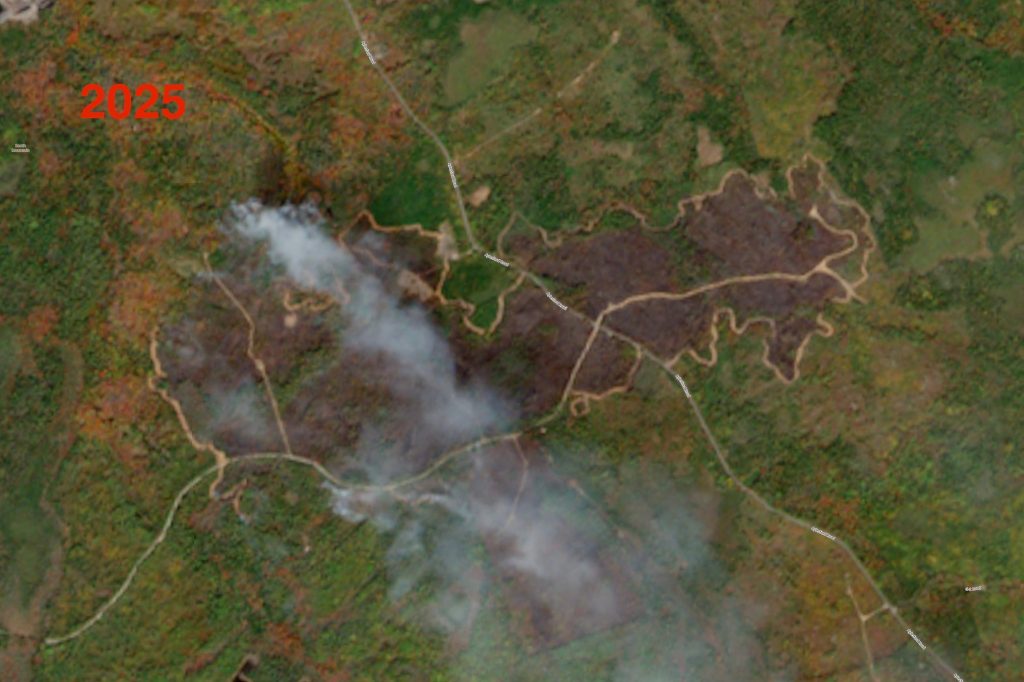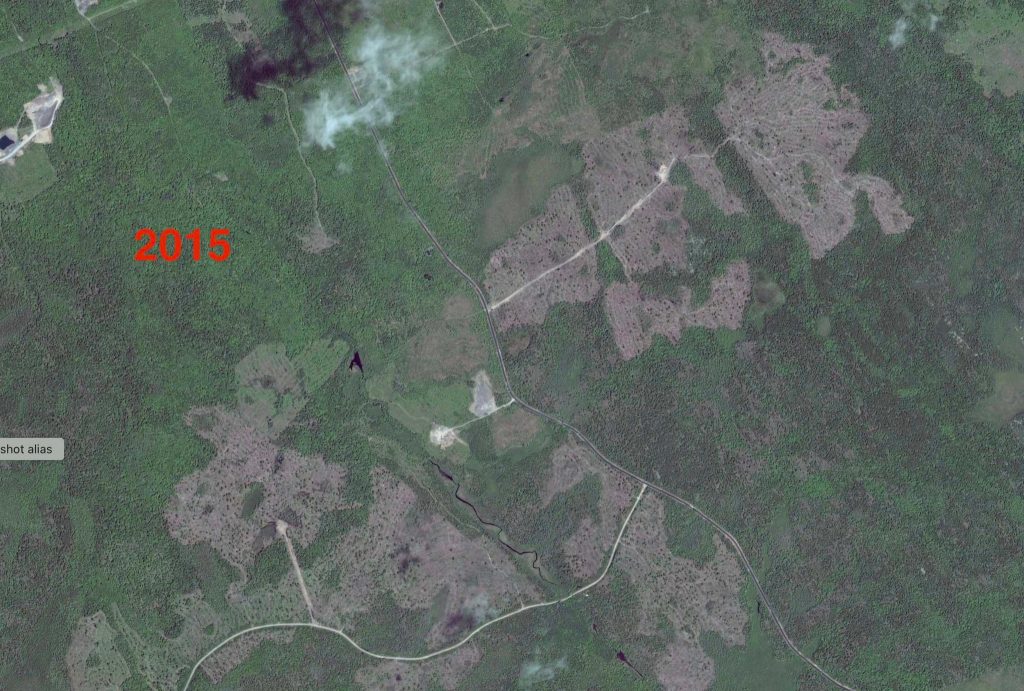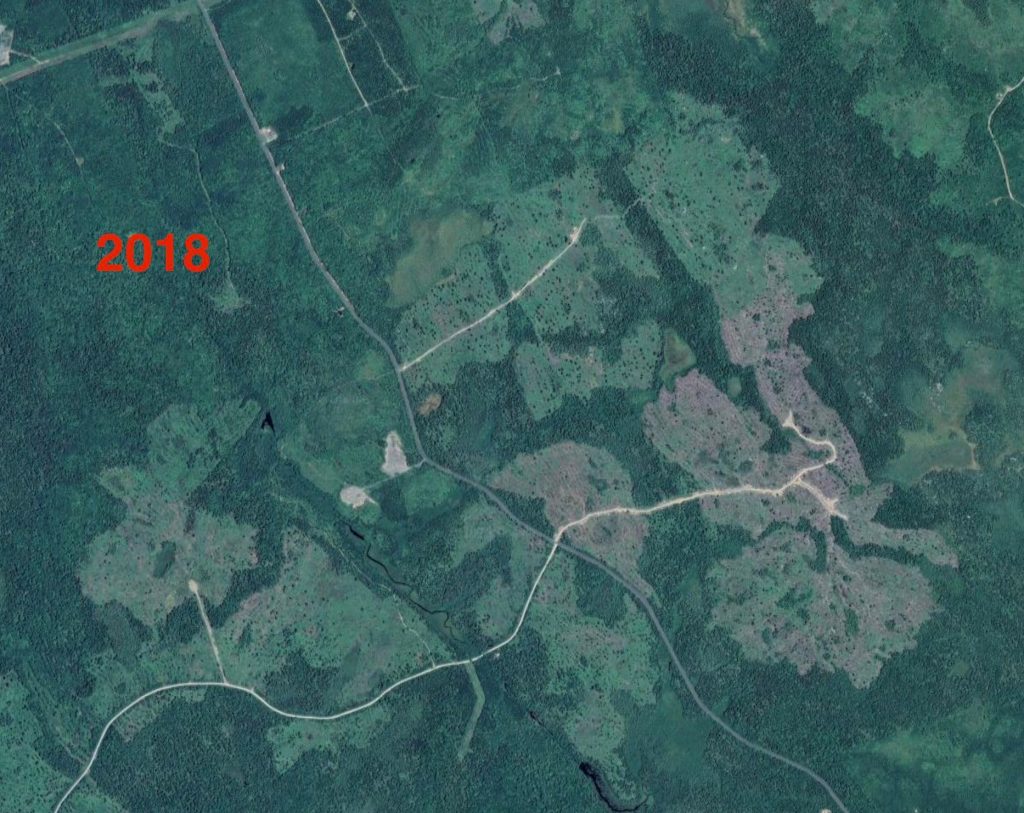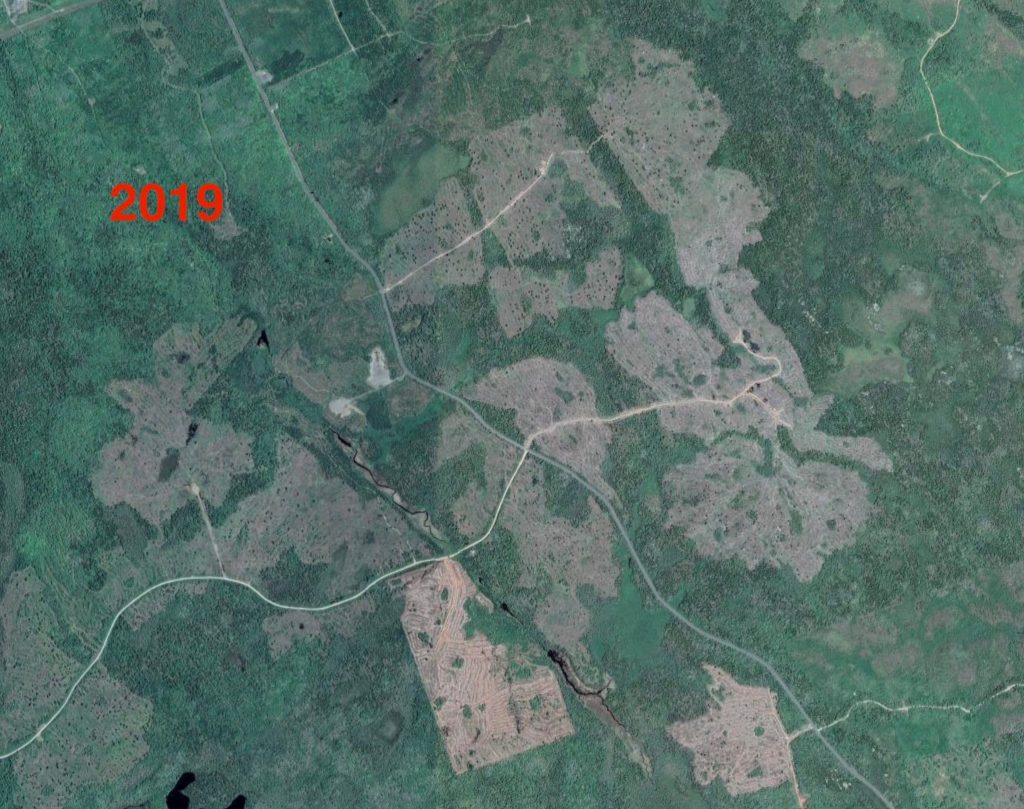NAVIGATION. This page is a subpage of In the News – Wildfire/Extreme Weather on the website Nova Scotia Forest Matters (www.nsforestmatters.ca)
Post by Bev W on Annapolis Environment & Ecology (Public FB page) Oct 5, 2025 copied below with excerpts from the discussion posts (43 as of 9 pm, Oct 5)
Bev W: ALL — I know we are all feeling bad that the forest north of Lake George is burning. However, we should try to remember that this was not a mature forest with a developed ecosystem. Yes, there would have been wildlife living in the areas that are now burnt, but we should really remember that these were pretty much all young areas of regenerating forest. Most of the oldest trees would have been about 10 years old at the oldest. To remind us all of this, I just used Google Earth to capture some maps of how the area looked in 2015, 2018, and 2019, and have posted the latest Copernicus satellite view of the current burnt areas. I think you should be able to orient the maps using the roads that pass through the area. I hope this is helpful for those of you who might be feeling sad. Give this area 5 to 10 years and it might be catching up to the way it was just a week ago.
From the Discussion
RW: Unbelievable…a picture tells a thousand words. An old growth forest would be full of dense moisture trapping mosses and a diversity of fire resistant deciduous species. A regenerating forest by contrast likely on already nutrient degraded soil, exposed to the unrelenting sun, would have a built in drought factor. And imagine, the lands of both NS and NB are riddled with these patterns.
Bev W to RW: That’s what scares the hell out of me. We have thousands of hectares of young regen forest growing on poor, rocky soil that is drought-stressed and baking in the hot sun. This is going to be a constant threat any time we have hot, dry conditions — which seems to be happening pretty often these last few years. With such thin, rocky soil, it wouldn’t even take much to dry out such young trees, making them extremely vulnerable to fire.
CAR: Unlike in B.C. where the slash is burned after a clearcut then young tree seedlings are planted for future growth. I hope those foresters from B.C. brought loggers calk boots with them.
Bev W to CAR: Even if slash was removed, it probably wouldn’t make much difference as I suspect what is going on fire are these young trees that are growing on thin, rocky soil that is probably completely dried down to dust. Both the young conifers and the deciduous would be pretty drought-stressed and “baked” from the radiant heat from the soil, and probably ready to go up like torches. And in those stands that have been sprayed with glyphosate to kill off the aspens, birch, etc.. the situation would be even that much worse.
RW: And don’t forget that outwest the emphasis is also on the same monoculture plantations of conifers.
CB to Bev W: and surely we are dreaming if we believe there is enough soil and enough nutrients to grow trees there again, for a long long time. Will be interesting to see what happens if/when we have a downpour rain. Perhaps is fairly level land.
Bev W to CB: I agree about the “dreaming” — I think mainly a “fantasy” that the forests will pop back up. I saw some photos of the dozer guards and other fire breaks and it looked like it was pretty much a ROCK GARDEN in there. What will be left of the organic matter over the rock after a fire like this? Scary thought, eh?
CP: Do we know how the fire started?
Bev W to CP: No. All they have said is that they are pretty much human origin – which is no surprise as there are no power lines on that lane, and there was no lightning. I don’t believe the claim that some people make about “a piece of glass” starting a fire. If that were so, considering all the busted glass all over the place at every forest and trail head in this province, there would be fires all over the place every day AND there would have been a fire at this location at some time in the past, so I call BS to claims about “a piece of glass”. It was probably just some careless person who threw a cigarette butt on the ground, or parked a vehicle with a hot exhaust system over some long grass, or some other stupid thing.
CP to Bev W: I’m just wondering if there was any logging activity there
Bev W to CP: As that whole area seems to have had all of its parcels logged in the past 10 years, I don’t really think there was much left there to be cut down, although there was one strip of taller trees that ran off from the lane where the fire started, but I don’t know if there was a parcel on that spot. I’m assuming there is some reason why a narrow strip of trees is across that part — perhaps a buffer along a small brook.
DGP: What started the wildfire is imp. to know, and def. we (in NS) are “lucky” in a way that lightening is rarely involved, and we do have some, even a lot of control over what starts wildfires here. So we need good stats on that from Gov… perhaps they exist**, on what has started wildfires in NS. But equally important is the question of what makes one area more susceptible than another to rapid growth of fire once started… and what control we might have over that. DNR has been hesitant to address these questions, at least publicly. There is growing evidence, made even clearer with the drought of 2025 that, contrary to the Big Forestry’s mantra that NS forests need to be “managed” to reduce forest wildfires [e.g. S.F.: “Forest management is not the problem. It’s the answer.”, Forest NS: “We will see more fires because it is getting harder to manage our forests actively. Active management means properly managing and harvesting in the forest and thinning areas where harvesting isn’t allowed.”] there are many aspects of past and ongoing forest management in NS that have made our forests more susceptible to rapid growth of fires, not less. The most obvious is the widespread practice of clearcutting – which dries out the landscape – followed by encouragement (with or without use of herbicides) of highly flammable softwoods over hardwoods, i.e. “borealization” of the Wabanaki/Acadian forest. .. That’s not just the “EcoFolks” thinking this way based on natural history perspectives, Anthony Taylor, professor of forest ecology at the University of New Brunswick (and a Nova Scotian born into a forestry family) thinks so as well, view discussion about it at https://nsforestmatters.ca/…/cbc-forestry-practices…; also see discussion of Forest NS views at https://versicolor.ca/…/hrm…/forest-ns-on-wildfires/. **Found some stats on proximate Causes of Wildfire in NS: https://novascotia.ca/…/fore…/wildfire/stats/2020gen.asp
Bev W to DGP: Thanks for commenting and also posting the link to read about Anthony Taylor’s views on how harvest practices are impacting forests and making them more prone to fires. I’m very much in agreement.
CS: I pray they plant Hardwood
CD to CS: exactly. The borealization of the Acadian forest is contributing to the instability. Coniferous monoculture is not good forestry practise. Out West, historically, the Cree would shelter under aspen forests when large fires came through, as the water in the leaves makes the deciduous canopy a protective shelter.
Bev W to CD: Yes, Exactly. There is a very good documentary called “Quebec On Fire” that was made after the huge wildfires in Quebec in 2023. They interviewed First Nations people from the areas and they said much the same thing – monoculture coniferous forests while the aspens and birch are being sprayed to get rid of them — making the forests extremely fire prone.
JC: Although it’s majorly a young area that’s burnt it’s was still a very ecological important area and had several bird species of interest breeding in areas that have burned. Olive-sided flycatchers and Yellow-bellied flycatchers both bred at this location unfortunately.
Bev W to JC: Yes, I agree, Jake. Even though it was an area with a lot of young regen, it was still habitat for birds and other creatures. This shouldn’t be happening, but I think we need to take a really hard look at how to avoid creating fire-prone forest stands — as David Patriquin has commented above. We keep hearing this mantra about how it is the “old forests” that need to be “managed” (gutted) to prevent fires, when those are EXACTLY the parts of the forests that are NOT burning up when a fire gets started.
SB to Bev W: Look to BC, they have done a lot of work on this. We need to stop the monoculture areas. Certain types of Hardwood make fire barriers, something the forest gurus here seem to lack the knowledge of.
Bev W to SB: Exactly. When you look at the Copernicus satellite views of the Long Lake Fire, there are areas right within the fire that are still green and also spots where the fire stopped — and when you check the PLV map of “leading species” of trees, those are the Red and Sugar Maple stands that did not burn…Production Forest stands — some right within forests that various communities have been trying to have protected. Yeah, like that’s going to turn out well
DH So Bev W its ok that the forest is burning because it’s only young trees and not old ones. You should try to tell that face to face with the ones that has to be evacuatef
BW to DH: NO!! Actually I DO NOT LIKE IT AT ALL. Obviously you do not “get” irony when you hear it. We keep being told that it’s okay to clear cut large areas of forest and NOW they want to start cutting down big swaths of old growth forests and making new “High Production Forests” right in the heart of the old growth forests. Well, can you figure out how well that is going to turn out? Try to understand what I’m trying to show you with these map
LH to BW: thank you so for explaining this so well. I believe your response shows great compassion as you think about the grief people feel watching so much forested area burning up. The fact that it not primarily healthy old growth forest should give some comfort. It certainly doesn’t mean you or I don’t care about all the other factors that cause grief. Unfortunately it is a consequence of man’s disrespect overall for our natural world.
Bev W to LH: Yes, I’ve been watching people expressing grief for the Long Lake Fire for weeks, and now the Lake George Fire. Yes, grief is justified — for the loss of wildlife habitat, for the damage that it has done to the landscape around people’s houses — some have lost homes — some have lost all the trees on their property and will now have a bleak view all around them. However, it is also important for people to understand that a lot of these forested areas were not mature, or old growth forests that, to me, are almost irreplaceable from an ecological point of view. These young forests growing up on previously harvested areas will grow back in time. I care about all forests — and about destroyed habitat. Young forests provide good habitat for a number of species of birds and mammals. At this point, what I am hoping is that we learn from these two large and dangerous fires.
BK: Actually, unless a fire is intentionally set by a human, which is terrible and i hope they get caught and fined, fires in forests during dry times is a natural process of nature and is part of the natural regeneration of forest eco system. The difference in our modern day time, is that we humans have encroached into the forest to build homes, cottages, use machinery, camp, throw out our cigarette buts etc.. and in addition to our human contribution to the problem is the changing climate. We have all read, heard for years the dire warnings of global scientists,climatologists, about how the planet is warming, 30 degrees weather it says for us tomorrow in mid October. Long range meteorological forecast modeling is for continued extreem drought in our Atlantic region and this valley for another two or three years. The more the planet warms the less fresh water there will be on the surface because evapotranspiriation rates increase, meaning ground and surface water evaporates faster. Some farmers have told me their well water has dropped 40 feet. The more the planets surface warms the further down underground water will migrate, in order to protect its self from evaporating.Ground water, under the fround, has a self preservation trait, it wants to be cool, not warm, so it goes further deep into the earth to kwep cool. Thats why homeowners wells near large clear cut areas often have to lower the foot valve in their wells in order to reach water again.
DGP to BK: Yes we could have more such years, but also very wet ones. The spring fires of 2023 were followed by extreme precipitation in June July August September, apparently or possibly associated with increased seawater temperatures causing more evaporation in the area of NS… I think the climate modelling can’t yet predict some of these extreme variations year to year. Hurricanes this year have not to date anyway been as many or as fierce as predicted. We in NS need to be prepared for both extremes, sometimes in the same year; either way clearcuts do not help, drying the soils out more rapidly in dry years and facilitating more flooding in wet years.
BK to DGP: yes, i agree, hoping the trend does not linger or repeat itself year after year. Municipal resivoirs in many areas are way down, yet still, no mandatory water restrictions have been issued many ns Municipalities still watered the lawns in their public spaces all summer. Sprinkler inspections in all public buildings, commercial, schools etc, coming due for renewal soon if their seasonal inspection test can’t sustain the required water pressure to operate the sprminkler system in the building, insurance companies, fire inspectors, buildjng codes wont renew the insurance meaning they wont be able to get an occupancy or operating renewal permit.
Bev W to DGP: We have to be prepared for more extremes. I know that, since I bought my property in 2010, the river beside my land has changed so much that it’s crazy. A week or so ago, I messaged with someone who grew up at a house very nearby and they described the river as being much like it was when I came here — and that would have been about 40 years prior. It is so volatile now — can go from nothing to a flash flood in hours. I’ve seen ducks and their ducklings actually swept away in the torrents. It now reminds me more of what I’ve experienced in my years spent in southern Arizona and in parts of Utah. When I came here, for spring and much of summer, the water was about waist deep in a sort of pool where I could swim around — and apparently it had been like that for decades. Not anymore. It’s usually no more than ankle to knee deep at the most — except during the flash floods. So much river stone has come down the river and filled in the “pool” where I swam — it’s just crazy. I suspect most of this instability has been caused by so much clear-cutting in the upper reaches of the river — there’s been a lot up there. I kind of hate to think of how that is all going to be compounded in these rivers coming off the south range now that the area has had 85 square kilometers of forest burnt up. I have asked in the past if there is a hydrogeologist working on the harvest approvals, but I’ve never received a reply.
CM:Hmmm… Wonder why it’s burning the way it is? Oh yeah that’s right, the forest floor is loaded with fuel left behind from the clear cutting. That’s where all the “junk” goes. When they cut anything that isn’t a tree trunk of suitable size gets left behind. So those areas are loaded with small, dry branches, tops, etc… they sit and dry and season for years until they either break down and rot away or a fire sweeps through and burns it up. Not exactly rocket science. As sad as it is and as much as I hope it gets put out soon (I only live about 10km East, as the crow flies) it’s actually good for the area in the long run. Cleans up a lot of the junk, renews the soil, resets bug populations, etc. It will return to balance and regrow again, it’s just part of nature’s.
